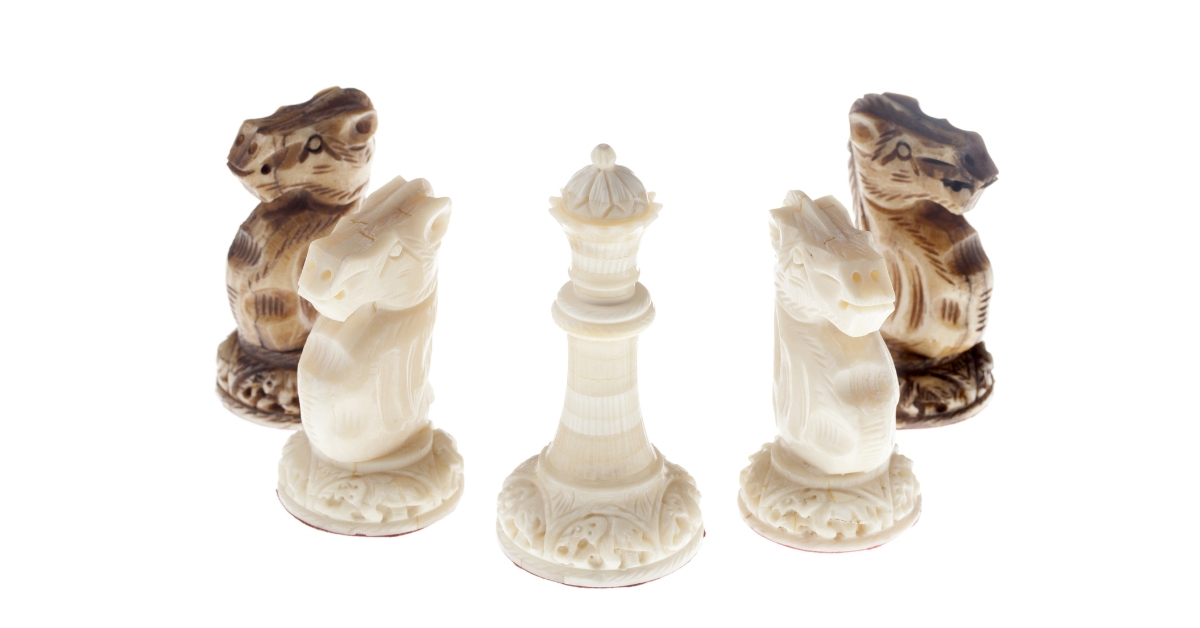
The Power of Queen & Knight: Why it Beats Queen & Bishop
After Ding Liren and Ian Nepomniachtchi exchanged blows in rounds 5 and 6, each winning their game with the Queen+Knight combination, we wanted to discuss this important topic. This blog aims to explain why Queen+Knight is a more effective and lethal combination than Queen+Bishop and display how Ding and Nepomniachtchi utilized this combination to achieve victory in their respective games.
So why do Queen and Knight work better than Queen and Bishop?
To answer the question of why the Queen + Knight combination is so effective, let's first understand the differences between knights and bishops. Bishops move diagonally across the board and can control vast space in open positions but are limited to the squares of a single color. Knights, unlike bishops, are not long-range pieces, but they can jump over pieces and control squares of both colors, making them a valuable tactical asset in certain situations. Knights are most effective in the center of the board, where they can control many squares that are inaccessible to other pieces.

Accordingly, the question of why the Queen + Knight combination is so effective has a very logical answer.
The queen can move like a bishop and it can move like a rook, but it cannot move like a knight. The unique movement of the knight makes it a great complementary piece for the queen. Together, they form a powerful duo that can control large portions of the board and threaten multiple squares simultaneously.
Importantly, however, chess doesn't have definitive answers. It all depends on the position, and in some situations, a bishop and queen can work better than a queen and a knight, but it mostly works the other way. Hence, let's see in which cases the Queen + Knight combo is most effective.
During Attacks
During attacks, a Queen and Knight combination can be particularly effective at attacking the opponent's king, as they can create multiple threats on squares of both colors. If the opponent has one bishop, they will be able to defend only one color complex, leaving their king vulnerable to the other color complex.
Tactical Considerations
When the queen is combined with a knight, it creates tactical opportunities that can be difficult for the opponent to defend against. The knight's unique movement allows it to fork and attack multiple pieces simultaneously, setting up powerful tactics such as discovered attacks and skewers. Additionally, the knight's ability to attack and control squares that are not easily accessible by other pieces, combined with the queen's flexibility, can create powerful mating nets and combinations.
Strategic Considerations
The strategic considerations of the queen and knight combination revolve around the strengths of the knight and the queen's ability to control the board. Knights are known for their flexibility and ability to maneuver through tight spaces, making them ideal for controlling the center of the board and attacking key squares. With the queen's range and power, the two pieces can work together to create powerful attacks and threats against the opponent's position.
During Short Games and Time Scramble
Knights can be tricky to defend against as they can jump over other pieces and attack from unexpected angles. This makes it more challenging for the opponent to anticipate and block potential threats from a queen and knight combination. Even if the defending side can actually succeed, they have to play very precisely, which is especially hard when the player has little time left or is playing a blitz game.
An excellent example of the effectiveness of the Queen and Knight combination can be seen in a blitz game played between Alexander Morozevich and Magnus Carlsen during the 2013 Tal Memorial. Despite having a winning position, Carlsen fell into a trap set by the Queen and Knight duo, which led to him being caught in a mating net.
Closed Positions
In closed positions where the board is cluttered with pawns and pieces, bishops can be hindered by their limited mobility, while knights can maneuver around more easily. This means that a queen and knight combination can be particularly strong in closed positions where the opponent's pieces are restricted. Especially with a centralized knight, the side with the queen and knight duo will have more chances of building and carrying out an attack.
Practical Examples from the World Championship Match
Finally, we get to the interesting part. Let's look at some practical examples from the World Chess Championship match between Ding Liren and Ian Nepomniachtchi. Rounds 5 and 6 were excellent demonstrations of the potency of the queen and knight duo on the board.
Round 5: Nepomniachtchi Wins
After exchanging a pair of knights, we have the Queen + Knight combination on the board. Nepomniachthci took full advantage of this duo and executed a beautiful strategic plan of bringing the Queen to d5 to control the light squares and transferring the knight to e4 to take care of the dark squares and support the pawn attack on the kingside. A great display of how complementary the two pieces are.
As mentioned previously, knights can create unexpected tactical opportunities. When allowing g5, Ding Liren missed that after Rg4, f6 was not an option since it loses to Nh4. If Black takes the knight, then h6 wins, and allowing the knight to land on g6 is equally destructive.
Hence, Black had to give the pawn back, and after a few moves, the white knight reached the central e4 square gaining total domination on the board.
Ding tried to escape the pressure by exchanging the queens, but it was too late. After, 41… Qe8 42. Kf3 Qa8 43. Qa8 Ra8 and 44. F6, Ding found himself in a hopeless endgame and had to resign shortly after.
Round 6: Ding Liren Strikes Back
The b1 knight was an essential piece in this game, making 10 of the 44 moves made by White. The beauty of the game starts after 29. Nd6, which brings the knight toward the kingside using a small tactic of 29…Qd6 30. Re8 winning the Queen.
After a few exchanges, Black found himself in a pawn-down position and started to push the “a” pawn in the hope of confusing White. However, Ding was determined to checkmate instead of going for technical endgame positions. Instead of 36. Rc7 Qg5 37. Qg5 which would lead to a won endgame position, he went for 36. Ne3! This move not only limited the Black queen’s ability to retreat to the kingside for defense but also prepared for a knight maneuver to d5-e7-g6.
While Black was busy defending his King with a single rook, the White knight managed to reach the e7 square from where it was able to threaten the weak squares around the Black king. Here Ding played the already-legendary d5 move, and the rest is history…
In conclusion, the Queen+Knight combination can be a lethal force in chess when utilized effectively. The two games from the ongoing World Chess Championship are great examples of the attacking potential, tactical considerations, and strategic advantages of this chess duo. As we continue to witness great chess battles of the World Championship, take a moment to read about the top interesting facts about this historical match.



